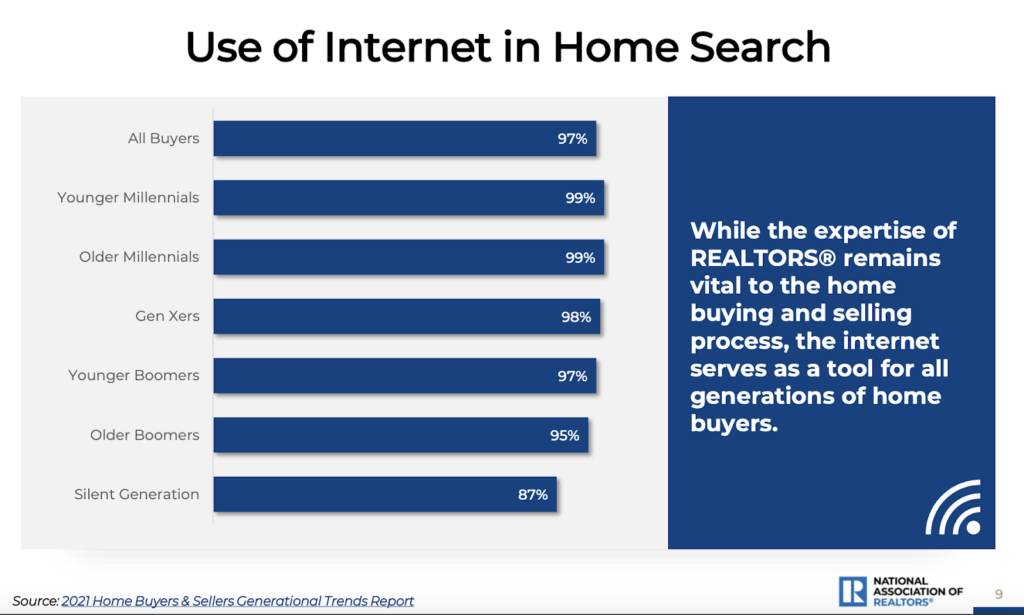47 Must-Know Real Estate Digital Marketing Statistics for 2024
Real estate digital marketing statistics show that it’s essential to optimize digital strategies to stay competitive in today’s market. The global real estate market is projected to hit $637.80 trillion by 2024, with the US market alone valued at...

Real estate digital marketing statistics show that it’s essential to optimize digital strategies to stay competitive in today’s market. The global real estate market is projected to hit $637.80 trillion by 2024, with the US market alone valued at $47 trillion.
On top of that, the U.S. is expected to generate $132 trillion in real estate value. With demand constantly growing, real estate marketing agencies, especially the ones in the US due to the competitive scene, need to fine-tune their digital approach to keep up with the trends and changes.
In this post, I’ve rounded up 47 key statistics to show how digital tools and trends are shaping the future of real estate. Before diving into the specifics, such as video marketing and social media statistics, here’s a brief overview of the industry as a whole:
The shift to remote work has led to a surge in suburban property demand. First-time home buyers made up 26% of all buyers in 2022, down from 34% in 2021. Millennials represent a significant portion of first-time home buyers, with 70% being younger millennials.Fast Forward
Real Estate Digital Marketing Statistics Real Estate Video Statistics Real Estate Social Media Statistics Homebuyer Online Behavior Statistics Real Estate Email Marketing Statistics Real Estate Photography StatisticsReal Estate Digital Marketing Statistics
When it comes to real estate marketing ideas and strategies, SEO, email marketing (which we’ll get into later), and paid ads have proven to be the most effective tools for agents and brokers alike.
54.2% of real estate agents’ marketing budgets are allocated to digital marketing in 2024. Content marketing is used by 23.1% of real estate agents in the U.S. Organic and paid search drive 57% of website visitors. Organic search has an average conversion rate of 3.2% while paid search has an average conversion rate of 1.5%. PPC (Pay-Per-Click) cost per click in the real estate industry ranges from $0.50 to $4.00. 61.7% of organic search users in real estate convert over the phone.Real Estate Video Statistics
Video marketing is an immersive way to highlight property features, helping buyers make decisions quickly after a thorough look at the home. Whether it’s virtual tours or drone footage, video content has become a must-have in real estate marketing.
Listings with video get 49% more qualified leads. 73% of homeowners say they prefer to list with an agent who uses video. Marketers’ most popular video kinds in 2021 were explainer videos (72%), presentation videos (49%), testimonial videos (48%), and sales videos and video advertising (42%). Listings with video generate 403% more inquiries. Video walkthroughs increase buyer confidence by 28%. YouTube is the most popular search engine among 51% of home purchasers. Marketers using video grow revenue 49% faster than non-video users. According to Hubspot, 81% of marketers have reported that video has helped them create leads.Real estate social media campaigns are a game changer for agents to reach out to more potential buyers and engage directly with them. These stats show just how important platforms like Facebook, Instagram, and LinkedIn have become for real estate marketing.
92% of U.S. realtors use Facebook for lead generation. 12% of realtors use TikTok to reach younger buyers. 51% of real estate professionals utilize social media to generate leads. Social media is used by 63% of real estate agents to advertise listings. Every day, 57% of realtors make use of social media to market their businesses. Despite its large user base, YouTube is only used by 26% of real estate agents. According to 46% of realtors, social media is the greatest source of high-quality leads. 90% of realtors use Facebook, followed by 52% on Instagram and 48% on LinkedIn.Homebuyer Online Behavior Statistics
With more buyers doing their research online, it’s vital for real estate agents to have a strong digital presence. These stats underline why being visible early in a buyer’s journey is so important, as nearly every generation depends on the internet to search for homes.

Real Estate Email Marketing Statistics
Email marketing is one of the most powerful tools for real estate professionals. It lets agents stay top-of-mind by delivering personalized, valuable content to potential buyers and sellers. Whether it’s property updates, market insights, or recommendations, email campaigns are an effective way to build relationships and convert leads.
54% of professionals use email to nurture long-term relationships. Real estate businesses have a 37.18% average email open rate. Email drip campaigns improve conversion rates by 25%. The average expected return on investment for email marketing is $40 for every $1 you spend. Email marketing has an ROI of 3,600%, converts 40% higher than social media, and has an average open rate of 25% in the real estate industry.Real Estate Photography Statistics
High-quality photos and interactive visuals are key to grabbing buyers’ attention. Listings with standout visuals not only catch more eyes but also sell faster, as more buyers are relying on images and virtual tours to make informed decisions.
89% of purchasers who used the internet to seek homes considered photographs essential. Homebuyers spend 60% of their time viewing listing photos, compared to just 20% on the description. 89% of all generations find photos essential, while 82% rely on virtual tours during their home search. Real estate listings with professional photography sell 32% faster than those without. Homes featuring aerial photos sell 68% faster than those without.As you can see, having a strong digital marketing strategy is crucial for real estate professionals today. Whether it’s using video to showcase properties or tapping into the power of social media, the right approach can really set you apart. These 47 statistics highlight just how important it is to stay ahead of the trends and meet buyers where they’re spending their time: online. By staying flexible and adapting to these shifts, you’ll be better positioned to succeed in 2024 and beyond.

 UsenB
UsenB 








_1.jpg)






















